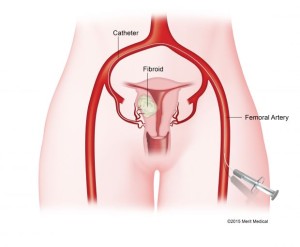Uterine Fibroid Treatment
Nonsurgical Uterine Fibroid Embolization – Myomectomy and Hysterectomy Alternative
 Uterine fibroid embolization (UFE), also known as uterine artery embolization, is a myomectomy and
Uterine fibroid embolization (UFE), also known as uterine artery embolization, is a myomectomy and
hysterectomy alternative. UFE’s are performed by an interventional radiologist, a physician who is trained to perform this and other types of embolization and minimally invasive procedures. It is performed while the patient is conscious, but sedated and feeling no pain. It does not require general anesthesia.
 The interventional radiologist makes a tiny nick in the skin in the groin and inserts a catheter into the femoral artery. Using real-time imaging, the physician guides the catheter through the artery and then releases tiny particles, the size of grains of sand, into the uterine arteries that supply blood to the fibroid tumor. This blocks the blood flow to the fibroid tumor and causes it to shrink and die.
The interventional radiologist makes a tiny nick in the skin in the groin and inserts a catheter into the femoral artery. Using real-time imaging, the physician guides the catheter through the artery and then releases tiny particles, the size of grains of sand, into the uterine arteries that supply blood to the fibroid tumor. This blocks the blood flow to the fibroid tumor and causes it to shrink and die.
UFE Recovery Time
Fibroid embolization usually requires a hospital stay of one night but with AI3’s outpatient center, this is not necessary. Pain-killing medications and drugs that control swelling typically are prescribed following the procedure to treat cramping and pain. Many women resume light activities in a few days and the majority of women are able to return to normal activities within seven to 10 days.
UFE Efficacy
- On average, 85-90 percent of women who have had the procedure experience significant or total relief of heavy bleeding, pain and/or bulk-related symptoms.
- The procedure is effective for multiple fibroids and large fibroids.
- Recurrence of treated fibroids is very rare. Short and mid-term data show UFE to be very effective with a very low rate of recurrence. Long-term (10-year) data are not yet available, but in one study in which patients were followed for six years, no fibroid that had been embolized regrew.
Additional UFE Facts
- In 2007, the first gorilla was treated with UFE for her fibroids.
- An estimated 13,000-14,000 UFE procedures are performed annually in the U.S. (as of 2004)
- Embolization of the uterine arteries is not new. It has been used successfully by interventional radiologists for more than 20 years to treat heavy bleeding after childbirth.
- Embolization has been used to treat tumors since 1966. Embolization to treat uterine fibroids has been performed since 1995 and the embolic particles are approved by the FDA specifically to treat uterine fibroid tumors, based on comparative trials showing similar efficacy with less serious complications compared to hysterectomy and myomectomy (the surgical removal of fibroids).
- Embolization of fibroids was first used as an adjunct to help decrease blood loss during myomectomy. To the surprise of the initial users of this method, many patients had spontaneous resolution of their symptoms after only the embolization and no longer needed the surgery.
- UFE is covered by most major insurance companies and is widely available across the country.
- Most women with symptomatic fibroids are candidates for UFE and should obtain a consult with an interventional radiologist to determine whether UFE is a treatment option for them. An ultrasound or MRI diagnostic test will help the interventional radiologist to determine if the woman is a candidate for this treatment.
- Many women wonder about the safety of leaving particles in the body. The embolic particles most commonly used in UFE have been available with FDA approval for use in people for more than 20 years. During that time, they have been used in thousands of patients without long-term complications.
Effect on Fertility
There have been numerous reports of pregnancies following uterine fibroid embolization, however prospective studies are needed to determine the effects of UFE on the ability of a woman to have children. One study comparing the fertility of women who had UFE with those who had myomectomy showed similar numbers of successful pregnancies. However, this study has not yet been confirmed by other investigators.
Less than two percent of patients have entered menopause as a result of UFE. This is more likely to occur if the woman is in her mid-forties or older and is already nearing menopause.
Risks
UFE is a very safe method and, like other minimally invasive procedures, has significant advantages over conventional open surgery. However, there are some associated risks, as there are with any medical procedure. A small number of patients have experienced infection, which usually can be controlled by antibiotics. There also is a less than one percent chance of injury to the uterus, potentially leading to a hysterectomy. These complication rates are lower than those of hysterectomy and myomectomy.
Surgical Treatments for Fibroids
Gynecologists perform hysterectomy and myomectomy surgery. Hysterectomy is the removal of the uterus and is considered major abdominal surgery. It requires three to four days of hospitalization and the average recovery period is six weeks.
Depending on the size and placement of the fibroids, myomectomy can be an outpatient surgery or require two to three days in the hospital. However, myomectomy is usually major surgery that involves cutting out the biggest fibroid or collection of fibroids and then stitching the uterus back together. Most women have multiple fibroids and it is not physically possible to remove all of them because it would remove too much of the uterus. While myomectomy is frequently successful in controlling symptoms, the more fibroids the patient has, generally, the less successful the surgery. In addition, fibroids may grow back several years later.
Myomectomy, like UFE, leaves the uterus in place and may, therefore, preserve the woman’s ability to have children.
August 2008 Practice Recommendations From American College of Obstetricians and Gynecologists Say Uterine Fibroid Embolization Is “Safe and Effective,” Based on Good, Consistent Level A Scientific Evidence
Based on long- and short-term outcomes, uterine fibroid embolization, a minimally invasive interventional radiology treatment for uterine fibroids, is a safe and effective option for women to consider. Women can and should be confident about their decision to consider UFE as a treatment option. Level A treatment choices are considered proven treatments that should be offered to patients for their conditions when discussing treatment options. ACOG’s Practice Bulletin is used to aid doctors in making decisions about appropriate patient care. Most women with symptomatic fibroids are candidates for UFE and should obtain a consult with an interventional radiologist to determine whether UFE is a treatment option for them.
Interventional Radiologists Can Provide Gynecologists and Their Patients Better Diagnosis and Minimally Invasive Treatment Options
Interventional radiologists use MRIs to determine if fibroids can be embolized, detect alternate causes for the symptoms and rule out misdiagnosis, identify which treatments are best suited for each patient and avoid ineffective treatments. Women typically undergo an ultrasound at their gynecologist’s office as part of the evaluation process to determine the presence of uterine fibroids. An MRI is a much better imaging tool for uterine fibroids than ultrasound because it can show underlying diseases and image all of the fibroids.
- Call to schedule a consultation: During your consultation you will be able to ask questions and be answered by a medical professional. This step will help you make an informed decision on whether embolization or hysterectomy is the right choice for you. Call 727-386-9981
- Day of consultation: Please arrive 20 minutes before your appointment to fill out necessary paperwork and a health questionnaire. Bring any patient history such as (pap smear results, ultrasound or MRI imaging and notes from your primary care doctor or gynecologist). During your consultation you will be able to ask questions plus get knowledgeable information to help you make an informed and educated decision on what procedure works best for you on treating your fibroids.
- Return for MRI: Once you have decided to continue with the fibroid embolization, you will be scheduled for an MRI if you have not already had one. An MRI will provide us with images to prepare for your procedure.
- The day of your procedure: Please arrive 20 minutes before your appointment time to https://cytecare.com/lasix-over-the-counter/ fill out additional paperwork and to go over simple instructions for your return home. Fibroid Embolization is a same day procedure, so you will be returning home that day with only a few days of down time. Please be sure to have someone with you. This person will be given a prescription for pain management as you will have minimal cramping and discomfort for a few days.
